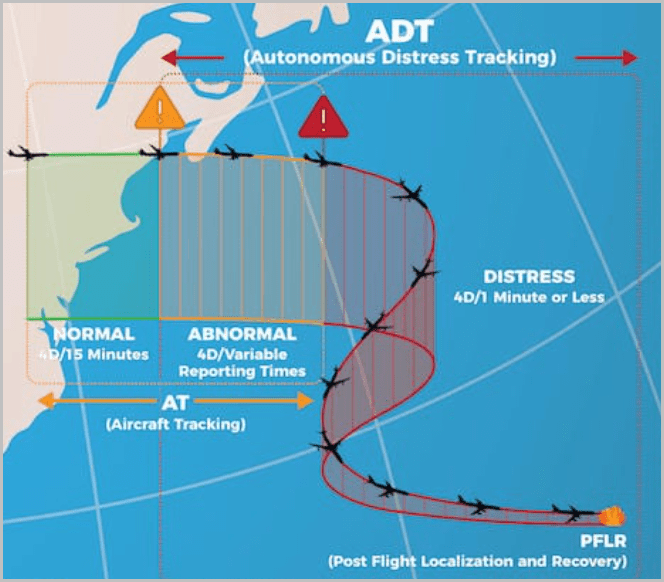
1 21 2022 1 11 11 PM
By now ADS-B technology is well understood. It allows for aircraft tracking which has become so popular and is now de rigueur for every avgeek with a smartphone. Which includes just about every reader of this site.
We spoke with Amir Bhatti, CEO of Star Navigation about the origins of GADSS: “After the sad disappearance of MH370, International Telecommunications Union (ITU) a subdivision of ICAO and United Nations, with the help of Malaysian Ministry of Telecom and MultiMedia organized “Expert Dialogue” on real-time flight tracking and DFDR downloads. They invited the avionics manufacturers along with aircraft manufacturers and airlines around the world.
I was fortunate to be the team lead on one of those groups tasked with identifying the use cases of DFDR data. We presented a lot of use cases on real-time flight tracking and DFDR data downloads. Fortunately, the ICAO mandated a few of them in the shape of the GADSS program in the later years. Ever since then, the industry is still struggling to provide the complete solution in a single avionics box with a dashboard that suffices the need to comply with GADSS requirements. Star Navigation is able to do it on a single platform where the end-users are able to identify the aircraft in distress in real-time and start streaming the DFDR data in both, forward and backward directions.”
What is GADSS? (Global Aeronautical Distress and Safety System)
The operational scope of GADSS is:
- Provide autonomous global, end-to-end tracking of commercial flights so that an aircraft is never “lost.” i.e., MH370
- The primary focus is the detection of aircraft in distress anywhere in the world, and to provide accurate tracking throughout a flight so Search & Rescue (SAR) procedure can be initiated, as needed and rescuers directed to the exact location. Time is of the utmost essence.
- The rapid reaction process enables timely retrieval of the FDRs.
In January 2023 aircraft operators will need to add another item to their aircraft reporting – GADSS. What is this all about? Here’s a quick background on the issue per ICAO’s website: “Shortly after the disappearance of Malaysia Airlines flight MH370, a special Multidisciplinary Meeting on Global Flight Tracking (MMGFT) was convened at the ICAO Headquarters in Montréal, Canada, to propose recommendations for future actions. One of the main decisions taken was the need for operators to pursue global tracking of airline flights at a faster pace.
ICAO does not have any regulatory authority to make this happen without agreement by individual country regulators. It appears that the ICAO requirements will be respected across the globe.
ICAO goes on to state: “The Global Aeronautical Distress and Safety System (GADSS) concept of operations was initiated at this meeting. The GADSS concept describes in an evolutionary manner the execution of actions in the short, medium, and long terms with each action resulting in benefits. The first steps in implementing the GADSS can be taken in the short term by implementing the Normal Aircraft Tracking solutions as proposed by the industry-led Aircraft Tracking Task Force (ATTF) for commercial air transport and by addressing the areas of improvement identified in GADSS Document.“
By March 2016, ICAO made some determinations on GADSS. The key points include:
- Aircraft with 19 or more seats need to have GADSS;
- An aircraft-tracking time interval of 15 minutes;
- A recommendation to all operations of aircraft with a take-off mass of 27,000 kg
- And as a requirement to all operations of aircraft with a take-off mass of 45,500 kg when flying over oceanic areas.
ICAO delayed its January 2021 date for its GADSS initiative until 2023. In an article in Aviation Today, it’s clear the way GADSS will be implemented is likely to be spotty. “Airlines and manufacturers need to have those national regulations in place before they can know with full certainty what they need to adjust for in terms of onboard systems, and in light of this we’ve had to provide all concerned with the extra equipage time the Council agreed to earlier in March 2020,” said Anthony Philbin, chief of communications at ICAO.
Is ADS-B is GADSS compliant?
A common response to the need for GADSS is to consider ADS-B sufficient. Chris Devlin, Aireon Director of Product Management shared this view: ”Aireon, the global leader in aviation safety data and analytics, provides high-fidelity surveillance and tracking information for all ADS-B equipped aircraft operating around the globe. The data stream enabled by Aireon can provide critical, real-time information to aircraft operators in the air and to key stakeholders on the ground with the common goal of safe operation of the aircraft.
Through its space-based ADS-B system, Aireon is able to provide update speeds and location tracking that exceeds ICAO standards for both aircraft operating normally and aircraft in distress. Additionally, Aireon has the ability to add contextual information around that safety-critical data to provide complete situational awareness of the airspace, further enhancing operating safety.
Aireon’s system has the ability to monitor aircraft performance and alert if an aircraft is operating outside of its flight envelope (quickly losing altitude, drastic change in speed, dramatic change in attitude, etc.), which could be a signal that the aircraft is in distress. Onboard ADS-B systems are physically separate (i.e. separate LRUs) but often connect to the aircraft’s flight management system.
Aireon is not a part of the ICAO GADSS working group, so would be unable to comment on the discussions and/or draft proposals by the group. However, Aireon and its data products are poised to respond, adapt, and support new standards as they hit the marketplace.”
ADS-B offers operators and regulators some sort of tracking around distress. This is focused on the vertical, not the horizontal. When one considers what MH370 went through, ADS-B should have notified the airline there was something afoot. It is unclear the airline was tracking the flight appropriately. If it was it would have noted the change in direction and reacted. If the ADS-B on MH370 was switched off, that too should have elicited a response from the airline. All these years later and still so many questions.
For regulators. and the traveling public, an independent source is needed to ensure that an MH370 doesn’t happen again. Hence GADSS.
ADS-B Can’t Meet All GADSS Requirements
GADSS enables distress reporting as noted by Skybrary. “An aircraft is considered to be in a distress condition when it is in a state that, if the aircraft event is left uncorrected, may result in an accident. Triggering criteria might include items such as unusual attitudes, altitudes or speeds, potential collision with terrain, total loss of thrust on all engines, Mode A squawk codes, and others as defined by the operator.”
ADS-B is insufficient for these items. Triggering items for GADSS is more flexible by tracking attitude and engine performance, for example. Fortunately for operators, GADSS solutions exist that can be retrofit into aircraft. Readers may recall the scramble to find ADS-B equipment and licensed installers as the window for requirements closed. Hopefully, the industry learned from that as GADSS requirements approach.
No airline can afford to be slow on the GADSS issue – although safety is never used as a marketing gimmick – GADSS compliance is likely going to be public knowledge. All it takes is a website tracking who has GADSS and who doesn’t. The traveling public will be informed and express their preferences.
Downstream GADSS Benefits
What is interesting is that the GADSS requirement enables operators to “up their game” in terms of flight operations. Once GADSS is implemented, the operator has essentially connected the avionics to a system that reports, via satellite, the aircraft’s performance. No longer is engine telemetry exclusive to the engine OEM. The operator (and anyone else with a need to know) also knows about fuel burn, oil burn, and thrust behavior.
But take it a step further – all the interested parties in an aircraft “food chain” stand to benefit. Banks, Insurers, and lessors can all track their assets in near real-time. This could be an industry first and the way this plays out is that firms with at-risk capital can monitor assets and their use/abuse. Clearly, this impacts the pricing of leases and insurance. More insight means sharper pricing – more data gives everyone deeper insight.
Operators (primarily airlines) will be able to add the data streaming to their OCCs data feeds. The location has always been the item showing on the huge map screens, where AOGs get prominence. But with aircraft performance data streaming, predictive maintenance is no longer the purview of a few. More and better data means a lower risk of an AOG. If it looks like something needs fixing, parts and a repair crew can be at the ready upon arrival of the aircraft. AOG will be minimized.
You can readily see why even MROs would want access to this information, tracking customer aircraft for which they are responsible. But. of course, there’s more. Data streaming will include aircraft attitude which allows operators to monitor pilot performance. Pilots are not going to appreciate this. But never mind egos. Hard flying and hard landings impact an aircraft’s asset value and maintenance. Not to mention passenger comfort. Transparency trumps ego, every time.
We think the GADSS initiative opens a host of powerful and useful information to further optimize flight ops and better pricing. It is, potentially, a situation where everyone in commercial air travel wins.
Louis Brandeis is credited with writing that “Publicity is justly commended as a remedy for social and industrial diseases. Sunlight is said to be the best of disinfectants; electric light the most efficient policeman.” GADSS seems to deliver a deeper level of transparency and simultaneously allow for much better visibility on not only where an aircraft is, but how it is performing. The reasons for embracing this effort are self-evident.
Views: 76




